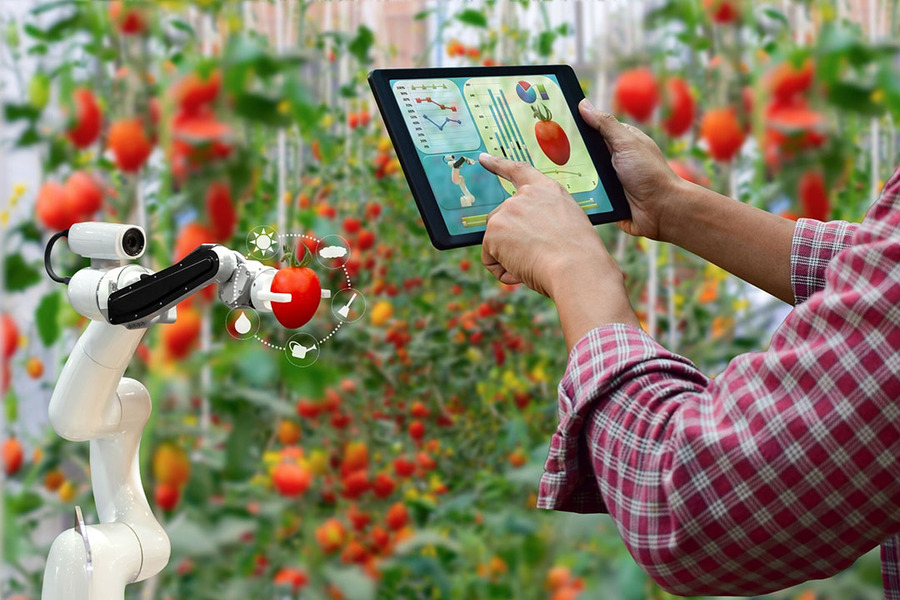AI Driven Quality Monitoring in Food and Agriculture
Transformation of traditional agricultural practices is very eminent in the last three decades due to lack of manpower, urbanization and other reasons. Consumer’s expectation also changed with respect to the quality of the agricultural and food products produced. Mechanization of agricultural practices, and applications of sensors for soil, crop and water management are increasing day by day in order to produce good quality products as per the consumer’s need. Introduction of artificial intelligence (AI) in agricultural and food manufacturing practices help the producers to achieve this goal. These AI based tools and techniques helps the farmers and food producers to keep a track on how food is grown, harvested, processed, and distributed, along with ensuring the production practices as well as products meets the quality and safety standards set by various regulatory bodies across the globe.
The food crop production must meet out the ever-increasing global demand due to the increasing global population, which is projected to reach 10 billion by 2050, the food production must keep up with the pace. Continuous decrease in farming area due to urbanization create another challenge for the farmers to produce enough food products. This demographic pressure, along with the challenges of climate change, necessitates introduction of innovative approaches to agricultural practices. AI presents itself as a powerful partner for food producers in tackling challenges like optimization of food production optimization, reduction of waste during food and agricultural production, and efficient distribution for products at right time with best quality to needy customers.
AI in Agriculture
Application of AI in agriculture is increasing day by day, ranging from land preparation to harvesting, as well as post-harvest processing.
Precision Farming: Adopting of AI in precision farming technologies has increased in last 5 years. AI-based precision farming technologies helps in data collection and analysis, developing machine learning models and use of remote sensing data to improvise the effectiveness and control at the farms. At the cultivation stage, AI-driven precision agriculture employs data analytics, machine learning models, and satellite imagery to make farming more precise and controlled. Data collected using the sensors and drones related to the soil health, moisture levels, and crop health, enabling the farmers to make informed decisions about planting, watering, weeding and applying fertilizers or pesticides.
Pest and Disease Detection: Pest and disease attack in the field is major reason for reduction in crop yield and quality. Detection of pests and diseases at right time or early stages will help in maintaining the quality of crops in the field. The AI algorithms developed for analyzing the imaging data collected by drones and other cameras like thermal cameras enhance the ability to identify signs of distress and symptoms of pest and disease attack well in advance and long before the human eye can detect them. This allows for timely intervention to adopt control measure, which helps in saving crops from potential damage and reducing the need for chemical treatments.
Automated Harvesting: Development of robots with AI-facility incorporated and autonomous harvester are transforming the harvesting process, by enabling precise identification, picking and handling of produce. These technologies ensure that only matured and ripped fruits and vegetables with high-quality are selected, reducing waste and improving overall quality.
Post-Harvest Quality Control
Once harvested, maintaining the quality of agricultural produce during storage and transportation is equally vital if not more. The AI-driven smart systems can monitor conditions in storage facilities in real-time, and adjust the environmental condition (temperature and humidity) to improve shelf-life while preserving the quality. In addition, Convolutional Neural Network (CNN) based models are used in the industry to identify defects and inconsistencies that make the product less desirable to the consumers. CNN can also be used to quantify the broken vs whole kernels ratio in certain products like cashews and almonds. Image processing combined with traditional ML models have also been applied to detect the quality of the cereal grains like wheat and rice grains by analyzing the size and shape distribution.
Supply Chain Optimization
AI plays a pivotal role in enhancing the efficiency of the supply chain, from farm to table. Predictive analytics can forecast consumer demand, manage inventory, and optimize logistics, ensuring that perishable goods are delivered fresh and good quality to the consumers. AI-driven systems are deployed to monitor and control the temperature and humidity during the logistics as well as storage, which help to maintaining the quality of the food. This not only improves the quality and safety of food but also contributes to sustainability by reducing waste.
Challenges and Future Directions
While the potential of AI in agriculture is immense, there are challenges to its adoption. These include the high cost of technology, the need for infrastructure in rural areas, and concerns about data governance. And also, there is a need for training and education to prepare farmers and agricultural workers with the skills to adopt AI technologies for agricultural practices effectively. With the rapidly evolving field of AI, its integration with the field of food and agriculture is set to deepen in coming years.
The application of AI in quality monitoring in the field of food and agriculture represents a paradigm shift, offering unprecedented opportunities to enhance quality, efficiency, and sustainability. By harnessing the power of AI, the agricultural sector can meet the growing global demand for food in a way that is both productive and sustainable. As we move forward, continued investment in research, innovation, and infrastructure will be crucial to realizing the full promise of AI in agriculture, ensuring food security and quality for generations to come.
Featured image:
Source:

